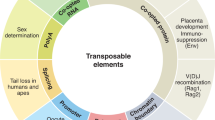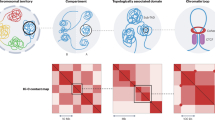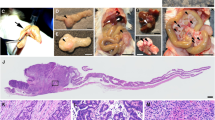Abstract
Transposons have provided important genetic tools for functional genomic screens in lower eukaryotes but have proven less useful in higher eukaryotes because of their low transposition frequency. Here we show that Sleeping Beauty (SB), a member of the Tc1/mariner class of transposons, can be mobilized in mouse somatic cells at frequencies high enough to induce embryonic death and cancer in wild-type mice. Tumours are aggressive, with some animals developing two or even three different types of cancer within a few months of birth. The tumours result from SB insertional mutagenesis of cancer genes, thus facilitating the identification of genes and pathways that induce disease. SB transposition can easily be controlled to mutagenize any target tissue and can therefore, in principle, be used to induce many of the cancers affecting humans, including those for which little is known about the aetiology. The uses of SB are also not restricted to the mouse and could potentially be used for forward genetic screens in any higher eukaryote in which transgenesis is possible.
This is a preview of subscription content, access via your institution
Access options
Subscribe to this journal
Receive 51 print issues and online access
$199.00 per year
only $3.90 per issue
Buy this article
- Purchase on Springer Link
- Instant access to full article PDF
Prices may be subject to local taxes which are calculated during checkout





Similar content being viewed by others
References
Spradling, A. C. et al. Gene disruptions using P transposable elements: an integral component of the Drosophila genome project. Proc. Natl Acad. Sci. USA 92, 10824–10830 (1995)
Bellen, H. J. et al. P-element-mediated enhancer detection: a versatile method to study development in Drosophila. Genes Dev. 3, 1288–1300 (1989)
Plasterk, R. H. The Tc1/mariner transposon family. Curr. Top. Microbiol. Immunol. 204, 125–143 (1996)
Osborne, B. I. & Baker, B. Movers and shakers: maize transposons as tools for analyzing other plant genomes. Curr. Opin. Cell Biol. 7, 406–413 (1995)
Ivics, Z., Hackett, P. B., Plasterk, R. H. & Izsvak, Z. Molecular reconstruction of Sleeping Beauty, a Tc1-like transposon from fish, and its transposition in human cells. Cell 91, 501–510 (1997)
Dupuy, A. J., Fritz, S. & Largaespada, D. A. Transposition and gene disruption in the male germline of the mouse. Genesis 30, 82–88 (2001)
Horie, K. et al. Efficient chromosomal transposition of a Tc1/mariner-like transposon Sleeping Beauty in mice. Proc. Natl Acad. Sci. USA 98, 9191–9196 (2001)
Fischer, S. E., Wienholds, E. & Plasterk, R. H. Regulated transposition of a fish transposon in the mouse germ line. Proc. Natl Acad. Sci. USA 98, 6759–6764 (2001)
Carlson, C. M. et al. Transposon mutagenesis of the mouse germline. Genetics 165, 243–256 (2003)
Luo, G., Ivics, Z., Izsvak, Z. & Bradley, A. Chromosomal transposition of a Tc1/mariner-like element in mouse embryonic stem cells. Proc. Natl Acad. Sci. USA 95, 10769–10773 (1998)
Horie, K. et al. Characterization of Sleeping Beauty transposition and its application to genetic screening in mice. Mol. Cell. Biol. 23, 9189–9207 (2003)
Yant, S. R. et al. High-resolution genome-wide mapping of transposon integration in mammals. Mol. Cell. Biol. 25, 2085–2094 (2005)
Collier, L. S., Carlson, C. M., Ravimohan, S., Dupuy, A. J. & Largaespada, D. A. Cancer gene discovery in solid tumours using transposon-based somatic mutagenesis in the mouse. Nature doi:10.1038/nature03681 (this issue)
Cui, Z., Geurts, A. M., Liu, G., Kaufman, C. D. & Hackett, P. B. Structure–function analysis of the inverted terminal repeats of the sleeping beauty transposon. J. Mol. Biol. 318, 1221–1235 (2002)
Geurts, A. M. et al. Gene transfer into genomes of human cells by the sleeping beauty transposon system. Mol. Ther. 8, 108–117 (2003)
Gao, Y. et al. A critical role for DNA end-joining proteins in both lymphogenesis and neurogenesis. Cell 95, 891–902 (1998)
Barnes, D. E., Stamp, G., Rosewell, I., Denzel, A. & Lindahl, T. Targeted disruption of the gene encoding DNA ligase IV leads to lethality in embryonic mice. Curr. Biol. 8, 1395–1398 (1998)
Wu, X., Li, Y., Crise, B. & Burgess, S. M. Transcription start regions in the human genome are favored targets for MLV integration. Science 300, 1749–1751 (2003)
Weng, A. P. et al. Activating mutations of NOTCH1 in human T cell acute lymphoblastic leukemia. Science 306, 269–271 (2004)
Ellisen, L. W. et al. TAN-1, the human homolog of the Drosophila notch gene, is broken by chromosomal translocations in T lymphoblastic neoplasms. Cell 66, 649–661 (1991)
Beverly, L. J. & Capobianco, A. J. Perturbation of Ikaros isoform selection by MLV integration is a cooperative event in Notch(IC)-induced T cell leukemogenesis. Cancer Cell 3, 551–564 (2003)
Davidson, A. E. et al. Efficient gene delivery and gene expression in zebrafish using the Sleeping Beauty transposon. Dev. Biol. 263, 191–202 (2003)
Grabher, C. et al. Transposon-mediated enhancer trapping in medaka. Gene 322, 57–66 (2003)
Liu, P., Jenkins, N. A. & Copeland, N. G. A highly efficient recombineering-based method for generating conditional knockout mutations. Genome Res. 13, 476–484 (2003)
Soriano, P. Generalized lacZ expression with the ROSA26 Cre reporter strain. Nature Genet. 21, 70–71 (1999)
Acknowledgements
We thank D. Swing and R. Koogle for generating the T2/Onc2 transgenic mice and maintaining all mouse strains, and E. Southon and S. Reed for generating mice carrying the RosaSB knock-in allele. This research is supported by the Department of Health and Human Services, National Institutes of Health and the National Cancer Institute.
Author information
Authors and Affiliations
Corresponding author
Ethics declarations
Competing interests
Dr Largaespada is a cofounder of Discovery Genomics Inc., which has licensed Sleeping Beauty technology from the University of Minnesota for applications unrelated to this work.
Supplementary information
Supplementary Figures S1 and S2
Supplementary Figure S1 shows generation and characterization of T2/Onc2 transgenic founders. Supplementary Figure S2 shows generation and characterization of RosaSB knock-in allele (PPT 2426 kb)
Supplementary Methods
Describes Southerns, Northerns and LM-PCR protocol (PDF 97 kb)
Supplementary Table S1
Lists all annotation data collected by cloning transposon junctions from double transgenic embryos (XLS 85 kb)
Supplementary Table S2
Lists all common sites of transposon integration identified in the data described in Supplementary Table S1 (XLS 18 kb)
Supplementary Table S3
Lists all annotation data collected by cloning transposon junctions from tumors (XLS 138 kb)
Supplementary Table S4
Lists all common sites of transposon integration identified in the data described in Supplementary Table S3 (XLS 33 kb)
Supplementary Table S5
Demonstrates the transposon orientation bias seen in the tumor data when compared with the embryo data (XLS 19 kb)
Supplementary Table S6
Lists pathways commonly affected by transposon integration in tumors (XLS 17 kb)
Rights and permissions
About this article
Cite this article
Dupuy, A., Akagi, K., Largaespada, D. et al. Mammalian mutagenesis using a highly mobile somatic Sleeping Beauty transposon system. Nature 436, 221–226 (2005). https://doi.org/10.1038/nature03691
Received:
Accepted:
Issue Date:
DOI: https://doi.org/10.1038/nature03691
This article is cited by
-
Sleeping Beauty transposon mutagenesis in mouse intestinal organoids identifies genes involved in tumor progression and metastasis
Cancer Gene Therapy (2024)
-
Sleeping Beauty transposon mutagenesis identified genes and pathways involved in inflammation-associated colon tumor development
Nature Communications (2023)
-
Mammalian genome innovation through transposon domestication
Nature Cell Biology (2022)
-
Exploring liver cancer biology through functional genetic screens
Nature Reviews Gastroenterology & Hepatology (2021)
-
Know Your Model: A brief history of making mutant mouse genetic models
Lab Animal (2021)
Comments
By submitting a comment you agree to abide by our Terms and Community Guidelines. If you find something abusive or that does not comply with our terms or guidelines please flag it as inappropriate.



